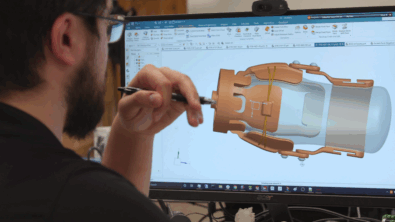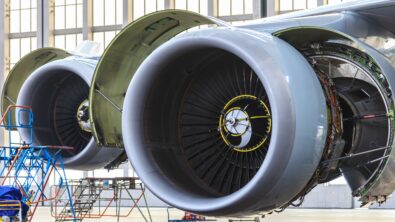The digital twin can power hydrogen aircraft

As the effects of climate change grow worse across the world, aviation companies are looking toward alternatives to fossil fuels to make aircraft more sustainable. There are many options to pursue, such as plant-based sustainable aviation fuels and electrification, but one option that has been gaining particular attention lately has been hydrogen. This attention is well earned, as hydrogen has a greater energy density than natural gas and gasoline, and only produces water as a byproduct after combustion. That being said, there are a number of challenges in producing green hydrogen and designing hydrogen-fueled aircraft that must be overcome to allow widespread adoption of hydrogen as an aviation fuel. A crucial tool in addressing these challenges will be the digital twin, which will aid in the design of next generation hydrogen-powered aircraft and the green hydrogen producing facilities that power them.
Manufacturing green hydrogen
One of the largest barriers to utilizing hydrogen is the difficulty in producing green hydrogen – which is produced through processes that emit little to no greenhouse gases – as opposed to black or gray hydrogen which produce substantial greenhouse gasses (you can find out more about the different types of hydrogen here). Producing hydrogen for sustainable use via unsustainable means defeats the purpose of hydrogen as a clean fuel, but currently 96-98% of global hydrogen production is done with black or gray methods. There are greener ways of producing hydrogen, namely the leading method of electrolysis, but for hydrogen to truly be green, the electricity used to power these processes must also come from a green source such as wind, solar, hydro, or nuclear. Yet currently, only a third of power generation globally comes from these sustainable sources. Other challenges include the intermittency of some sustainable power sources like wind and solar, as well as the high cost of electrolyzer materials used during electrolysis. A massive overhaul in energy infrastructure and hydrogen manufacturing will be needed if the aviation industry wants to make the transition to true green hydrogen.
Challenges of hydrogen fuel
Even once producing a stable supply of green hydrogen is achieved, designing aircraft that can safely use hydrogen fuel is another matter entirely. Hydrogen is incredibly flammable, making it difficult to safely store and handle. It also has the smallest atomic radius of any element, meaning the hydrogen atoms can actually pass through sufficiently porous materials. Hydrogen storage tanks must therefore be designed to keep hydrogen stable and prevent it from escaping into the atmosphere, which presents a danger to other aircraft systems. While there are existing technologies that can utilize hydrogen for power, each of them has caveats of their own. Hydrogen fuel cells have been used since the times of the Apollo moon missions and are highly efficient, but have lower energy density compared to combustion, making them less suitable for large planes. Combustion gas turbines are widely used and fuel flexible, meaning they can be used to combust hydrogen fuel with few modifications. However, the combustion of those fuels will produce toxic NOX emissions, and hydrogen fuel produces different flame structures and higher temperatures, which can damage gas turbines not designed to accommodate them. New aircraft will have to be designed radically different from current fossil fuel aircraft to accommodate the demands of hydrogen fuel and guarantee safe flights.
Simulating hydrogen with the digital twin
Fortunately, the comprehensive digital twin can be an invaluable tool in solving these problems and has even already paved the way toward solutions. Thanks to the digital twin’s simulation capabilities, engineers can model complex power systems and measure emissions, power consumption/output, and more qualities virtually before the physical systems are constructed. These abilities have already been used to create a proof-of-concept for a green hydrogen production facility and provide virtual modeling for hydrogen fuel cells and gas turbines. Engineers will also be able to use the digital twin to model how those systems interface with the other systems of a simulated hydrogen-fueled aircraft, allowing them to better predict and correct any potential obstructions in the design phase. Although producing green hydrogen and designing sustainable aircraft will present many challenges, the digital twin is a powerful and versatile tool that will help engineers rise to meet them.
Hydrogen is worth the effort
The number of challenges in producing green hydrogen and designing hydrogen-fueled aircraft may seem daunting, but the high energy output and zero emissions of green hydrogen are more a more than worthy goal to work toward. Companies can achieve those outcomes with the assistance of the digital twin, which they can use to simulate the complex power dynamics involved in producing green hydrogen, as well as aid in the design of new components and systems that will let hydrogen-fueled aircraft fly. With a combination of perseverance and the comprehensive digital twin, aviation companies can transform the industry for an era of cleaner, sustainable flight.
Siemens Digital Industries Software helps organizations of all sizes digitally transform using software, hardware and services from the Siemens Xcelerator business platform. Siemens’ software and the comprehensive digital twin enable companies to optimize their design, engineering and manufacturing processes to turn today’s ideas into the sustainable products of the future. From chips to entire systems, from product to process, across all industries, Siemens Digital Industries Software is where today meets tomorrow.


